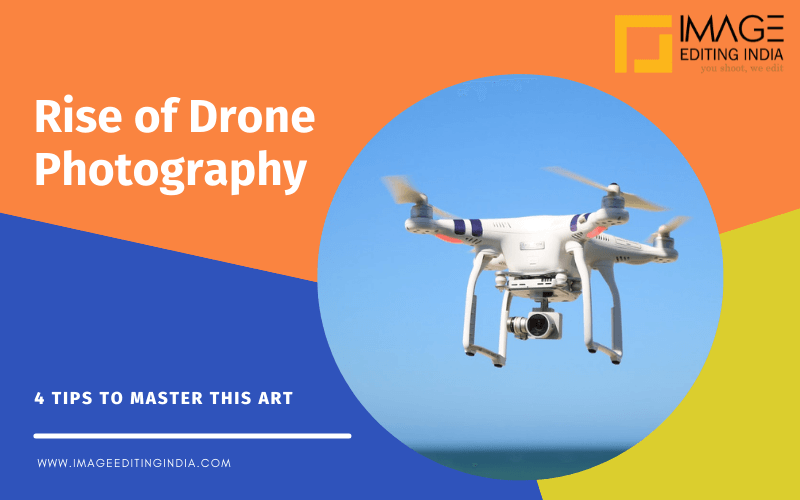
Rise of Drone Photography for Stunning Aerial Captures – 4 Tips to Master this Art
Photography comes in many aspects. What seemed impossible for humans to capture years ago, is now being possible with advancements in technology and methodology. This is what drone photography brings.
What is Drone Photography?
How do you capture the stills of places that are hard to reach or some of the most stunning aerial images that can’t be taken in a normal mode at the ground? By using a drone – an aerial autonomous unmanned, sky-high flying camera that is operated remote-controlled. Technically it is known as Unmanned Aircraft System (UAS), but commonly as a drone.
What Aerial Images & Videos Drones Capture?
Aerial images that are not possible for human photographers & videographers can be captured easily and effectively by using drones. These operate enabling a first-person view, so the photographer can remotely see what is in the sight of the drone, and therefore capture the stills or make videos specific to their requirements. Drones come in different sizes and abilities so as to fit different drone photography needs.
It can be easily said that drones have changed the entire photography game, allowing for effectual aerial captures with unique compositions and perspectives. These are able to bring a new-age photography addition to professionals and enthusiasts pertaining to what was not possible before or what seemed to be extremely expensive earlier.
Drones allow you to look at some the stunning views and transformed landscapes from a bird’s-eye view. Shooting straight down allows capturing formations and patterns that you could not have imagined to exist without this technique.
Why Drones Have Become So Popular Nowadays for Aerial Photography?
While aerial images were captured earlier too, those were done by only a few because of the expensive aircraft-based methods, especially in movies and by government organizations and such; drone photography in today’s times can be used by individuals too who have a passion and love for photography. This has been enabled by the relative affordability of drones, which are available in multiple types, sizes, and photography-specifics. These devices have allowed photographers a new perspective that is quite exciting and amazing.
How to Prepare for Drone Photography?
Are you looking to master this art? While you may think that owning a drone could be enough for you to capture aerial shots, it isn’t so. When you want your photos and videos to be shot from the best angle and provide stunning results that look professional, you need to work on the basics and fundamentals of drone photography tricks.
From learning to pilot the drone, take-off, and landing of the unmanned vehicle, to follow the legal regulations for drone navigation, below appended tips will help you to get the most and succeed as a drone photographer:
How to Pick the Drone
Should you own a built-in or onboard camera drone? For drone photography, the most important aspect is your drone. So choose one that is based entirely on what you need in the image and video result, and what goes well with your photography skills. You should pick a drone that you can learn and fly easily.
Know the Drone Features and Functions
Knowing the features, functions, and capabilities of your drone is important so you are able to effectively optimize the drone-fly time. Some of the popular drone features/capabilities are:
- Smartphone Feed – It gives you a real-time view of what your drone is shooting
- Smart Mode – A feature for beginners that helps navigate challenging situations and conditions
- Tracking – This means you are being kept in the frame always, enabled with a visual recognition feature
- Geofence – Your drone shouldn’t move out of control; it shouldn’t violate flying regulations. Therefore, this feature restricts how high and far your drone could go
Read the Operating Instructions – Understand the Legal Regulations
To operate your drone the best and safest way, you must read the entire instructions fully at first. It will detail you on all things related to drone facets and its working.
As a flying vehicle, you have to know what regulations have been put in place by your local, state or national authorities, so you keep flying your drone in accordance with the set rules.
- Understand the Challenges
- Image Quality – Image quality is different than normal cameras. So you must set it up accordingly and adjust to that, with respect to the mobility.
- Weather – It is recommended that you don’t fly your drone in extreme windy or cloud conditions.
- Piloting – piloting a drone might be a new thing but it isn’t that much hard as well. Look at all the factors to pilot your drone the best way – including safety, respect others’ privacy, watching out for the crowd also.
- Photo Finishing: Before the final photo, if it needs any expert help for some photo editing, you can contact any photo editing services.
Conclusion:
To become a master in drone photography you must always have a habit of pre-checking your device components, weather, surrounding, and controls. Test drive your drone in the beginning, keep learning drone photography techniques, learn how to post-process the photos, and make use of external add-ons like propeller guards, extra propellers, extra SD cards, and LED lights.
